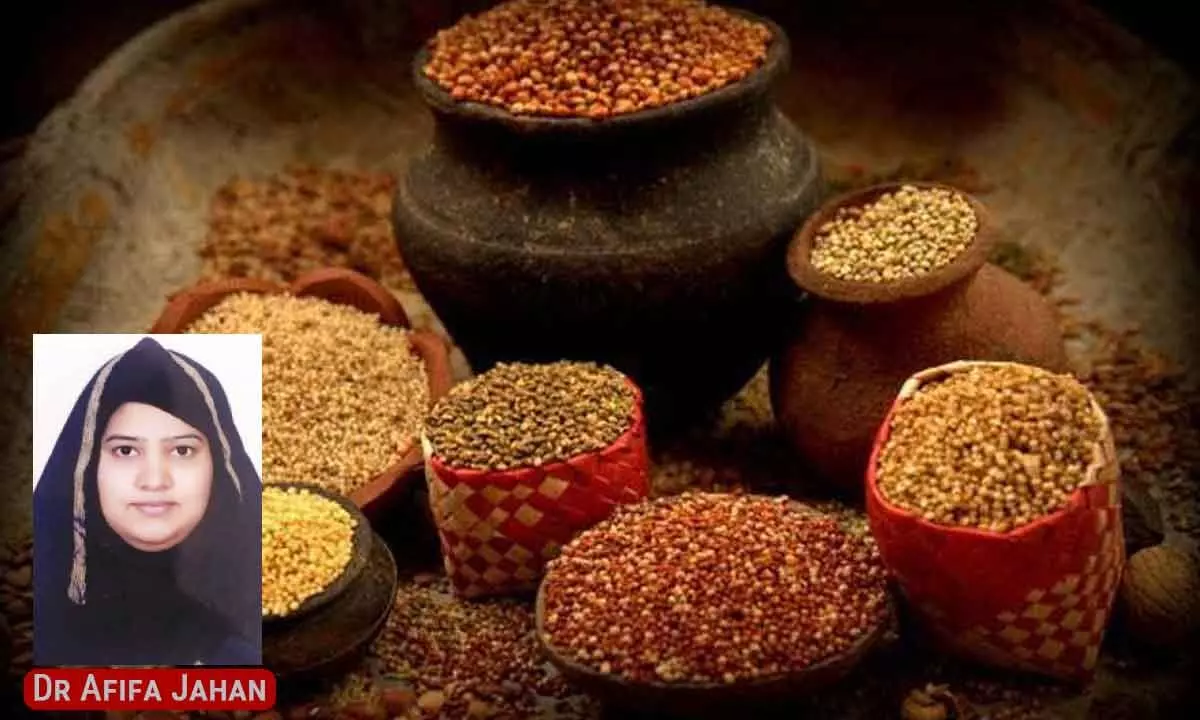Millets Magic

Dr Afifa Jahan, PhD in Food and Nutrition talks about how millets will help in managing diabetes
Diabetes mellitus is moreover recognised as diabetes, a crew of metabolic troubles which are characterised by the capability of the way of immoderate (high) blood sugar diploma hyperglycemia over an extended measurement of time.
Types 1 and 2 are labelled as diabetes (Nolan, 2019). Type 1 diabetes is moreover described as juvenile diabetes or insulin-dependent diabetes as a sufferer’s pancreas cannot manufacture or produce insulin (Shen, 2018). Although type 2 diabetes (T2D) commonly takes vicinity first in adults at any time, the physique will emerge as insulin resistant or fails to supply sufficient insulin.
1. Millets for Diabetes Control
Dietary management is a simple and within-your-capacity way to grant preventive benefits and increase the standard of life for those with type-2 diabetes. Hence, the current guidelines for type-2 diabetes are to undertake safe, nutritious diets, particularly with low-GI (glycemic index) starchy carbohydrates and elevated dietary fibre that can help manage post-prandial hyperglycemia and minimise body weight. A low glycemic carbohydrate/high-fibre eating regimen has been shown to effectively lower plasma cholesterol and increase blood glucose stability for type 2 diabetes (Boulton, 2017).
Millet manufacturing charge of quite an extensive range international locations in the world. Recent studies have analysed the high implications of millet on type 2 diabetes threat markers (Saito, 2006). However, these studies showed that the results of randomised trials to consider the GR (glycemic response) consequences of millet have been contradictory, with some of the utilisation of brief intervention situations or constrained samples that would reduce the validity of the results. Millets have in reality as, low amino acid ranges and large fat content. However, 75% of this fat is not hazardous to the heart, and it is safe. It carries polyunsaturated fatty acid, which is surprisingly very good for health.
Millets such as jowar, ragi, and bajra are used to make a very imperative phase of the Indian diet. Thus, they are additionally recommended by means of the ability of diabetologists truly due to the reality they are identified for encouraging diabetes management steps. The high fibre content material of millet approves the level of sugar in the bloodstream to gradually down. Indeed, it would be better to argue that digestion delays increase even sugar distribution. Diabetologists suggest millets for sufferers due to their capacity to decrease the danger of type 2 diabetes and cardiovascular disorders (Tang, 2018).
2. Pearl Millet and Its Nutritional Significance
Pearl millet (Pennisstum glaucum) is a multifunctional cereal crop which belongs to the Poaceae family. It is commonly referred to in a traditional Indian language as bajra, bajri, sajje, kambu, kamban, sajjalu, etc. It is considerably used for ingredients and forages. Pearl millet is India’s 1/3 biggest important crop after rice and wheat. It used to be developed in a region of 7.4 million, averaging 9.13 million tons, in 2017–2018. Rajasthan, Maharashtra, Gujarat, Uttar Pradesh and Haryana are our country’s best pearl millet-growing states.
3. Pearl Millet and Diabetes
Pearl millet helps hold regular blood sugar ranges for an extended time in diabetic patients. It is, in addition, genuinely beneficial for people living with diabetes due to the fact it has a comparatively low glycemic index that helps readily digest and consist of glucose at a slower rate than other food items. This will usefully help to maintain healthy blood sugar levels for prolonged stretches.















